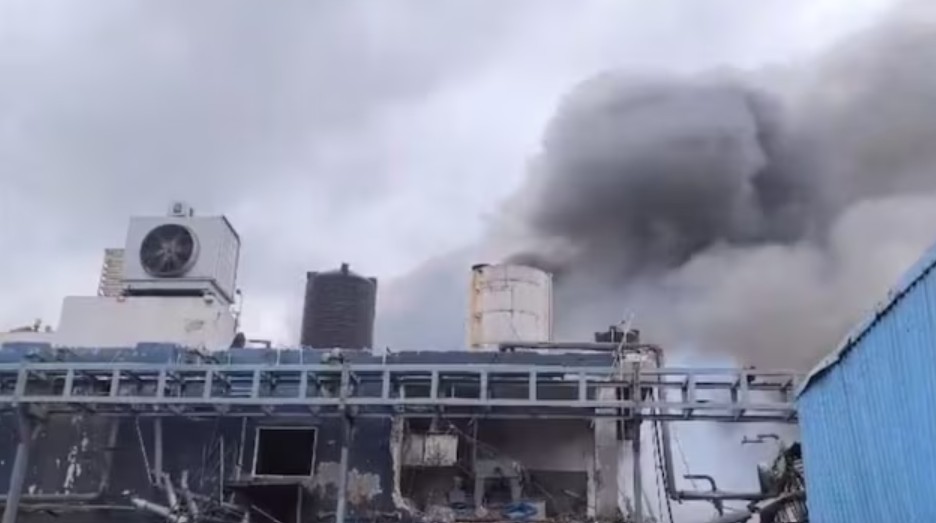Massive Explosion at Hyderabad Chemical Factory Sparks Safety and Environmental Concerns
4 min read
Hyderabad, June 30, 2025 – A catastrophic explosion rocked the SB Organics Limited chemical factory in Hyderabad’s Patancheruvu industrial area on Monday, triggering widespread alarm and raising urgent questions about industrial safety and environmental hazards. The blast, which occurred around 6:00 PM, led to a massive fire that engulfed the facility, sending thick plumes of toxic smoke into the sky. Authorities have confirmed at least four fatalities, with 10-15 others injured, while rescue operations continue amid fears that more workers may be trapped inside the debris.
Background: A Growing Industrial Hub Under Scrutiny
Hyderabad, a burgeoning hub for pharmaceutical and chemical industries, has witnessed rapid industrial growth in areas like Patancheruvu and Cherlapalli. However, this expansion has often come at the cost of safety oversight, with several factories operating in densely populated zones. The SB Organics facility, located in Telangana’s Sangareddy district, specializes in chemical manufacturing, handling volatile substances that pose significant risks if not managed with stringent safety protocols. Monday’s explosion marks the second major industrial incident in Hyderabad within a week, following a fire at a chemical factory in Cherlapalli, highlighting systemic issues in the region’s industrial safety framework.
Breaking Down the Incident
What Happened?
The explosion at SB Organics Limited is believed to have originated from a reactor malfunction, causing a violent blast that shattered windows and threw workers back with its force. The resulting fire rapidly spread, fueled by flammable chemical barrels stored within the facility. Eyewitnesses reported hearing multiple secondary explosions, complicating firefighting efforts. Videos circulating on social media captured chaotic scenes of workers and residents fleeing as flames and dense black smoke billowed from the factory.
Immediate Response
Emergency services, including six fire tenders and ambulances, were deployed swiftly to the scene. The local police cordoned off the area to ensure public safety and facilitate rescue operations. Telangana Chief Minister Revanth Reddy personally reviewed the situation, directing fire department officials to expedite rescue efforts and bring the blaze under control. The injured were rushed to nearby hospitals, where they are receiving treatment for burns and respiratory issues caused by smoke inhalation.
Casualties and Damage
The District Fire Officer confirmed the recovery of four bodies from the site, with unverified reports suggesting additional casualties. The explosion’s intensity caused significant structural damage to the factory, and authorities are assessing the risk of further collapses. The surrounding area, home to residential colonies, has been affected by poor air quality due to toxic fumes, prompting health advisories for residents.
Why This Matters: Safety and Environmental Implications
Industrial Safety Gaps
The incident underscores persistent concerns about safety standards in India’s chemical industry. Experts point to inadequate fire safety audits, outdated equipment, and lax regulatory enforcement as key contributors to such disasters. Comparisons with similar incidents in industrial hubs like Gujarat’s Vapi and Maharashtra’s Tarapur reveal a troubling pattern of non-compliance with fire safety norms. The Hyderabad explosion has reignited calls for mandatory real-time monitoring systems, regular safety drills, and stricter penalties for violations.
Environmental Fallout
Chemical factory fires pose severe environmental risks, releasing hazardous toxins into the air and potentially contaminating nearby water bodies. Hyderabad, already grappling with air pollution, faces long-term ecological challenges from such incidents. The thick smoke from the SB Organics fire has raised concerns about respiratory health among residents, while firefighting runoff could pollute local water sources. Environmentalists are urging authorities to enforce stricter waste management protocols and conduct immediate air and water quality assessments in the affected area.
Voices from the Ground
Local residents expressed fear and frustration, with many evacuating their homes as a precautionary measure. “We heard a loud blast, and within minutes, the sky was black with smoke,” said Priya Reddy, a resident of Patancheruvu. “This isn’t the first time something like this has happened. The government needs to act before more lives are lost.”
Civic activist Dr. Anjali Sharma, who has long campaigned for industrial safety reforms, stated, “This tragedy was preventable. Factories handling dangerous chemicals must be held to the highest safety standards. We need real-time oversight and accountability, not just promises.”
Government and Industry Response
Chief Minister Revanth Reddy has assured a thorough investigation into the cause of the explosion, with preliminary reports pointing to a reactor failure. The Telangana government has promised financial assistance for the victims’ families and enhanced medical support for the injured. Meanwhile, industry bodies have called for a review of safety protocols across Hyderabad’s chemical sector, emphasizing the need for collaboration between regulators, companies, and local communities.
What’s Next?
As rescue operations continue, authorities are focused on accounting for all workers and assessing the full extent of the damage. The investigation into the explosion’s cause is expected to shed light on whether negligence or equipment failure played a role. Environmental agencies are also monitoring the area for potential contamination, with early reports indicating elevated levels of particulate matter in the air.
The SB Organics explosion serves as a stark reminder of the risks inherent in India’s industrial growth story. For Hyderabad to maintain its reputation as a safe and sustainable industrial hub, policymakers must prioritize robust safety regulations, invest in modern firefighting infrastructure, and engage with communities to address their concerns. Without these measures, the city risks further tragedies that could have far-reaching consequences for its people and environment.





